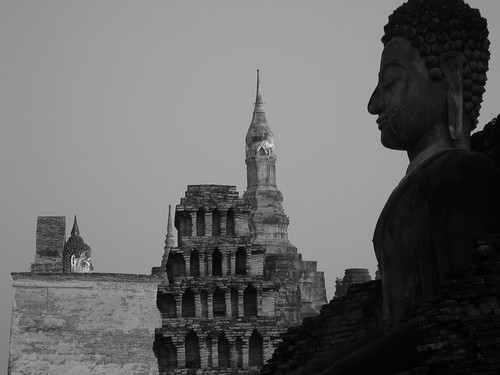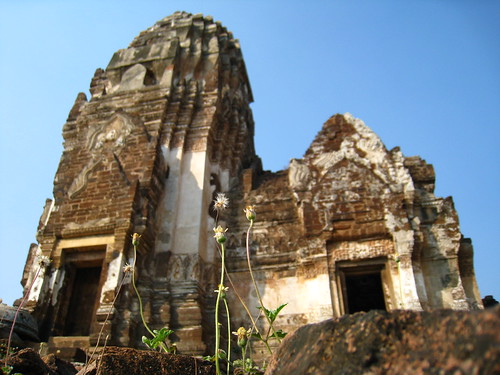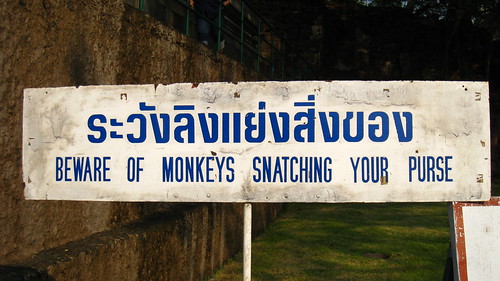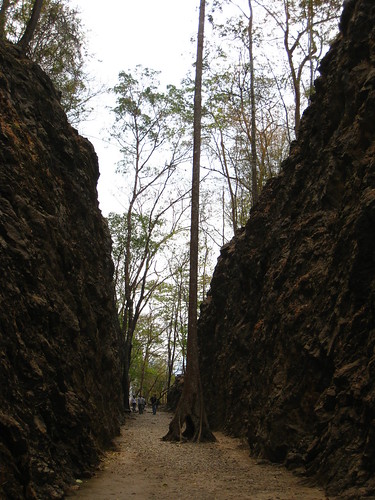 I left Bangkok for northern Thailand via the ancient kingdoms of central Thailand. Ayutthaya, Lopburi, and Sukhothai have amazing ruins with few tourists. I often had the ruins to myself, giving the trip an essential Indiana Jones quality apart from all of the antiquities having been taken and the rows of headless Buddhas. Travelling by train is a great way to see Thailand and Thais. Before heading north I went on a day trip along the Death Railway to Hellfire Pass.
I left Bangkok for northern Thailand via the ancient kingdoms of central Thailand. Ayutthaya, Lopburi, and Sukhothai have amazing ruins with few tourists. I often had the ruins to myself, giving the trip an essential Indiana Jones quality apart from all of the antiquities having been taken and the rows of headless Buddhas. Travelling by train is a great way to see Thailand and Thais. Before heading north I went on a day trip along the Death Railway to Hellfire Pass. Third class trains are a great way to see Thailand and Thais. The windows are wide and open. The country rushes by and, apart from the odd fire with the ensuing influx of flying embers, the coaches with bench seats are a relatively comfortable way to travel. The locals are surpised to see a farang travelling with them in third class. I always managed to find myself near a Thai who spoke English and wanted to chat. The thai passengers are an endless list of characters, ably supported by the food vendors wandering between the carriages. Third class is also cheap as chips. The journeys from Bangkok to Ayutthaya and Ayutthaya to Lopburi both only cost 15B. The five hour journey to Phitsanulok cost 125B. A great source of information for train journeys in Thailand (and the rest of the world) is www.seat61.com.
 Ayutthaya is an hour north of Bangkok by train. It is an ancient capital of Siam and was founded in 1350. It is a natural island surround by the Lopburi, Prasak and Chao Phraya Rivers. The great aspect of the ruins of Ayutthaya is how they have survived next to a modern Thai town. Half the island is given over to the town while the other half has the ruins scattered around. Ayutthaya is a Thai town going about its business with the ruins in the background. The ruined temples do not appear to have been heavily reconstructed. Wat Chaiwatthanaram sitting on the river was particularly picturesque with the setting sun behind it. It is very easy to wander around the temples. There is an admission fee of 20-30B for each temple. I was standing outside one ruin with lots of Rooster statues when an old Thai woman appeared next to me with a lotus flower and candles. I protested that I wasn't Buddhist and shouldn't really be praying to Buddha, but she didn't understand and I didn't want to be rude to an old woman. I paid for them (10B) and she prayed for me, it then turned out we were going to another Buddha shrine (I paid another 10B) and she prayed for me again, we then went to a third shrine (I paid 10B again) and she prayed for me again. People feeling the need to pray for me appears to be a habit I have got into. The train station is on the eastern side of town. I hired a long boat and visited the temples on the rivers surrounding the island. It cost me 500B and was a great way to see them. There is a cross river ferry that will take you into town. I was surprised to find so few tourists and guesthouses. I can only assume that because it is so close to Bangkok people simply visit on day trips. Even so I only saw a couple of groups of tourists at a few of the more famous temples, otherwise I had the place to myself.
Ayutthaya is an hour north of Bangkok by train. It is an ancient capital of Siam and was founded in 1350. It is a natural island surround by the Lopburi, Prasak and Chao Phraya Rivers. The great aspect of the ruins of Ayutthaya is how they have survived next to a modern Thai town. Half the island is given over to the town while the other half has the ruins scattered around. Ayutthaya is a Thai town going about its business with the ruins in the background. The ruined temples do not appear to have been heavily reconstructed. Wat Chaiwatthanaram sitting on the river was particularly picturesque with the setting sun behind it. It is very easy to wander around the temples. There is an admission fee of 20-30B for each temple. I was standing outside one ruin with lots of Rooster statues when an old Thai woman appeared next to me with a lotus flower and candles. I protested that I wasn't Buddhist and shouldn't really be praying to Buddha, but she didn't understand and I didn't want to be rude to an old woman. I paid for them (10B) and she prayed for me, it then turned out we were going to another Buddha shrine (I paid another 10B) and she prayed for me again, we then went to a third shrine (I paid 10B again) and she prayed for me again. People feeling the need to pray for me appears to be a habit I have got into. The train station is on the eastern side of town. I hired a long boat and visited the temples on the rivers surrounding the island. It cost me 500B and was a great way to see them. There is a cross river ferry that will take you into town. I was surprised to find so few tourists and guesthouses. I can only assume that because it is so close to Bangkok people simply visit on day trips. Even so I only saw a couple of groups of tourists at a few of the more famous temples, otherwise I had the place to myself.  I stayed at Bann Kun Phra which has an excellent restaurant on the river. The rooms have ensuite cold showers but the walls are paper thin. I paid 300B for a double bed. It is a fine place to stay apart from the woman who runs it, who seemed to be somewhat paranoid and became increasingly suspicious of me during my stay.
I stayed at Bann Kun Phra which has an excellent restaurant on the river. The rooms have ensuite cold showers but the walls are paper thin. I paid 300B for a double bed. It is a fine place to stay apart from the woman who runs it, who seemed to be somewhat paranoid and became increasingly suspicious of me during my stay. I caught another third class train for the hour journey to Lopburi. Lopburi does not have the extensive ruins of Ayutthaya or Sukhothai but the ruins it does have are amongst the old town. The old palace is well preserved and sits in the centre of the old town. There is a museum in its grounds as well as some hedges cut into the shape of elephants. Opposite the train station are more ruins. To the south of the old town are the remains of a temple known locally as Monkey Temple. It is swarming with monkeys. So much so that local guides wander around with sticks to keep them in check. I had one monkey run up my leg and jump on top of my backpack. The monkeys are not restricted to the temple they
I caught another third class train for the hour journey to Lopburi. Lopburi does not have the extensive ruins of Ayutthaya or Sukhothai but the ruins it does have are amongst the old town. The old palace is well preserved and sits in the centre of the old town. There is a museum in its grounds as well as some hedges cut into the shape of elephants. Opposite the train station are more ruins. To the south of the old town are the remains of a temple known locally as Monkey Temple. It is swarming with monkeys. So much so that local guides wander around with sticks to keep them in check. I had one monkey run up my leg and jump on top of my backpack. The monkeys are not restricted to the temple they  have infiltrated the town. They use the telephone lines to cross roads and get between the buildings. I spent a good hour watching a group of monkeys leave a path of destruction through the town centre. A similar problem has befallen Prachuap Kiri Khan, a charming little seaside town south of Bangkok. The monkeys on Chong Khra Chok hill have large grounds but they are moving into the rest of town. It is peculiar to see monkey's running riot in a petrol station. If you arrive at the train station in Lopburi looking for accommodation walk out of the train station turn right and then left and you will find the Tourist Information office who will provide you with a map. I stayed at Nett Hotel, 200B for an ensuite cold shower with TV.
have infiltrated the town. They use the telephone lines to cross roads and get between the buildings. I spent a good hour watching a group of monkeys leave a path of destruction through the town centre. A similar problem has befallen Prachuap Kiri Khan, a charming little seaside town south of Bangkok. The monkeys on Chong Khra Chok hill have large grounds but they are moving into the rest of town. It is peculiar to see monkey's running riot in a petrol station. If you arrive at the train station in Lopburi looking for accommodation walk out of the train station turn right and then left and you will find the Tourist Information office who will provide you with a map. I stayed at Nett Hotel, 200B for an ensuite cold shower with TV. A 5 hour train journey took me to Phitsanulok, where I caught a bus to Sukhothai an hour away. The ruins at Sukhothai Historical Park are considered the best in Thailand. Sukhothai was founded in the 13th century and was the first capital of Siam. The most famous temple is Wat Mahathat which is full of Buddha images. Sukthothai Hiostorical Park is broken up into zones and you buy a ticket for each zone. The most restored ruins are in the centre, inside the city walls. Outside of the city walls (especially to the West and South) you are surrounded by countryside as you cycle around. The ruins aren't amazing outside of the centre but it is still very enjoyable. There are a couple of amazing temples to the West and North. Wat Saphan Hin has a huge standing at the top of a hill. At the bottom of the hill is a very happy policeman. He has a little hut and seems charmed by his surroundings. He'll watch your bike and try and sell you some water.
A 5 hour train journey took me to Phitsanulok, where I caught a bus to Sukhothai an hour away. The ruins at Sukhothai Historical Park are considered the best in Thailand. Sukhothai was founded in the 13th century and was the first capital of Siam. The most famous temple is Wat Mahathat which is full of Buddha images. Sukthothai Hiostorical Park is broken up into zones and you buy a ticket for each zone. The most restored ruins are in the centre, inside the city walls. Outside of the city walls (especially to the West and South) you are surrounded by countryside as you cycle around. The ruins aren't amazing outside of the centre but it is still very enjoyable. There are a couple of amazing temples to the West and North. Wat Saphan Hin has a huge standing at the top of a hill. At the bottom of the hill is a very happy policeman. He has a little hut and seems charmed by his surroundings. He'll watch your bike and try and sell you some water.  Wat Sri Chum is also amazing with a huge seated Buddha squeezed between 4 walls. In the Lonely Planet they suggest that you stay in Phitsanulok and catch a bus to the ruins in Sukhothai. I really liked Sukhothai. It is a typical Thai town with few tourists. There isn't a great deal going on but what there is is Thai. I saw an Elephant wander down the street one night. I stayed at TR Guesthouse run by a very friendly couple. I had a double bed with hot water ensuite for 250B, it also included free internet. The owner will even pick you up from the bus station, his telephone number is 055-611-663. If you want to stay as close as possible to the ruins then there are a number of guesthouses inside the city walls of the Historical Park and they seem to charge similar prices to Sukhothai.
Wat Sri Chum is also amazing with a huge seated Buddha squeezed between 4 walls. In the Lonely Planet they suggest that you stay in Phitsanulok and catch a bus to the ruins in Sukhothai. I really liked Sukhothai. It is a typical Thai town with few tourists. There isn't a great deal going on but what there is is Thai. I saw an Elephant wander down the street one night. I stayed at TR Guesthouse run by a very friendly couple. I had a double bed with hot water ensuite for 250B, it also included free internet. The owner will even pick you up from the bus station, his telephone number is 055-611-663. If you want to stay as close as possible to the ruins then there are a number of guesthouses inside the city walls of the Historical Park and they seem to charge similar prices to Sukhothai.  My train travel's in Thailand began before I left Bangkok when I went on a day trip along the Death Railway. The Death Railway is synonymous with pain and suffering. 13,000 Allied Prisoners of War and another 80,000 Asian labourers died building the line. Thai railways run a day trip along what is left of the line. The day trip isn't to commemorate the history of the railway but to visit Sai Yok waterfall at the end of the line. It costs only 100B for the return journey and makes for a cheap day out for Thai families. I was the only farang on the train apart from a Japanese guy (who was going to the waterfall). I didn't ask him about his views on the history of the line. The day trip is a full day, the train left at 6.30am and didn't get back until 9pm. As the only Farang aboard I was the subject of great interest. People wanted their photographs taken with me and to say hello. On the return journey to Bangkok I boarded at a different station to everyone else because I didn't visit the waterfall. My absence appeared to cause a great deal of confusion on board, its embarrassing to lose your only farang. My return at the next station down the line was greeted by much enthusiasm, a round of applause followed my walk through the carriages. The first stop was at Kanchanaburi for the Bridge over the River Kwai. The river was originally called Mae Khlung, the railway runs alongside the River Kwae but doesn't cross it, due to the success of the film the Thai authorities changed the name of the river. Kanchanaburi is heavily built up with tourism and when we arrived late in the morning the bridge was packed with tourists (you can walk over it). The end of the line is Nam Tok, it is a much smaller and nicer town than Kanchanburi.
My train travel's in Thailand began before I left Bangkok when I went on a day trip along the Death Railway. The Death Railway is synonymous with pain and suffering. 13,000 Allied Prisoners of War and another 80,000 Asian labourers died building the line. Thai railways run a day trip along what is left of the line. The day trip isn't to commemorate the history of the railway but to visit Sai Yok waterfall at the end of the line. It costs only 100B for the return journey and makes for a cheap day out for Thai families. I was the only farang on the train apart from a Japanese guy (who was going to the waterfall). I didn't ask him about his views on the history of the line. The day trip is a full day, the train left at 6.30am and didn't get back until 9pm. As the only Farang aboard I was the subject of great interest. People wanted their photographs taken with me and to say hello. On the return journey to Bangkok I boarded at a different station to everyone else because I didn't visit the waterfall. My absence appeared to cause a great deal of confusion on board, its embarrassing to lose your only farang. My return at the next station down the line was greeted by much enthusiasm, a round of applause followed my walk through the carriages. The first stop was at Kanchanaburi for the Bridge over the River Kwai. The river was originally called Mae Khlung, the railway runs alongside the River Kwae but doesn't cross it, due to the success of the film the Thai authorities changed the name of the river. Kanchanaburi is heavily built up with tourism and when we arrived late in the morning the bridge was packed with tourists (you can walk over it). The end of the line is Nam Tok, it is a much smaller and nicer town than Kanchanburi.  The railway line is particularly scenic between Kanchanaburi and Nam Tok, passing over Wampo Viaduct. I hired a sawngthaew, for the extortionate rate of 600B, to Hellfire Pass. My sawngthaew driver was in no hurry and whenever we were on even a slight descent he took the car out of gear and let it roll. When I finished at Hellfire Pass I came back to find him sound asleep. Hellfire Pass was a particularly bad section of the line for the POWs they were forced to cut through solid rock without machinery. It was called Hellfire Pass due to the deathly figures cast on to the walls by the fires lit when the POWs were forced to work through the night. A POW who worked here came back in the early 1980s to find it. He found Hellfire Pass covered in jungle and enlisted the support of the Australian Government to clear it and turn it into a memorial. It is a moving monument to the men who were forced to work and die here.
The railway line is particularly scenic between Kanchanaburi and Nam Tok, passing over Wampo Viaduct. I hired a sawngthaew, for the extortionate rate of 600B, to Hellfire Pass. My sawngthaew driver was in no hurry and whenever we were on even a slight descent he took the car out of gear and let it roll. When I finished at Hellfire Pass I came back to find him sound asleep. Hellfire Pass was a particularly bad section of the line for the POWs they were forced to cut through solid rock without machinery. It was called Hellfire Pass due to the deathly figures cast on to the walls by the fires lit when the POWs were forced to work through the night. A POW who worked here came back in the early 1980s to find it. He found Hellfire Pass covered in jungle and enlisted the support of the Australian Government to clear it and turn it into a memorial. It is a moving monument to the men who were forced to work and die here.
No comments:
Post a Comment